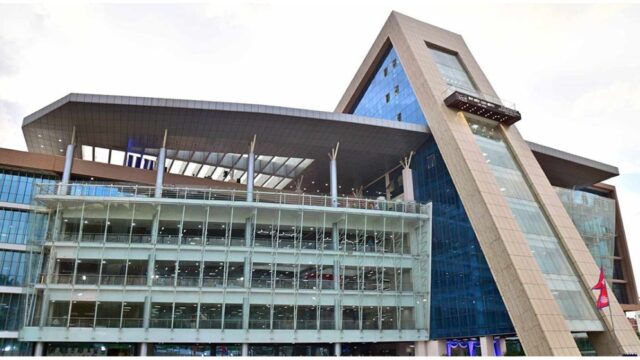The Gandaki Province Government has constructed a trekking trail leading to the Snow Leopard Cave located near Thini village in Gharapjhong-5, Mustang, with the aim of promoting tourism and preserving a unique natural and cultural heritage site. The cave is one of ten tourist destinations listed by the provincial government in Mustang and holds significant environmental, religious, and archaeological importance.
Preservation and Promotion of Rare Cave Site
This rare cave, long revered by locals and monks, has been a subject of interest for its spiritual value and biodiversity significance. The Tourism and Industry Office under the provincial government spearheaded the construction of the route and supporting infrastructure to both preserve and promote the cave.
As part of the annual approved program for the current fiscal year, the office allocated NPR 2 million for the development of the trail and associated facilities. According to the Office Chief, Prem Paudel, approximately 300 meters of uphill stone steps and railings were constructed from the trailhead to the cave to ensure safe and convenient access for visitors.
Reinforced Protection Near Cave Site
To protect the area from environmental degradation, a gabion wall (wire mesh structure) was installed on the steep slope near the cave. This will help in stabilizing the terrain and preventing erosion while also preserving the integrity of the cave and its surroundings.
Chief Paudel added that the project was implemented through a local consumer committee, ensuring community involvement and ownership in the development and conservation effort. Such a participatory approach is expected to encourage local stewardship of the cave, which is deeply integrated into the local culture.
Tourist Attraction Enhanced with Snow Leopard Sculpture
As part of efforts to attract tourists and create a symbolic identity for the cave, a sculpture of a snow leopard mother and cub has been installed at the entrance of the trail. This iconic structure is intended to represent the cave’s name and create a visual appeal for visitors.
The sculpture was crafted by local artisan Kungga Gurung from Waragung-4 Tiri, using traditional techniques and local materials. It serves as a striking welcome feature and highlights the region’s commitment to preserving its natural and artistic heritage.
Local Language and Spiritual Significance
Locally known in the Thakali language as “Thekkum”, the Snow Leopard Cave is located on a rugged slope at an altitude of 2,900 meters above sea level, near Thini village. The site is revered as a spiritual retreat where the renowned monk Urgen Palsang once practiced deep meditation. According to Paudel, several meditation rooms still exist within the cave, preserving its legacy as a spiritual sanctuary.
Interestingly, during the trail construction, two additional caves were discovered nearby, bringing the total number of known Snow Leopard Caves in the area to three. This discovery adds to the site’s mystique and potential for further archaeological and ecological research.
Snow Leopard Habitat and Research Significance
The highlands above Thini village are recognized as a natural habitat for rare and endangered wildlife, including the elusive snow leopard. Conservationists and researchers have identified the cave as a significant location for the study of snow leopards and their behaviors, which led to its official designation as the Snow Leopard Cave.
This cave and its surrounding area are considered highly valuable for biodiversity studies and are being increasingly recognized by wildlife researchers and nature enthusiasts for fieldwork and observation.
Tourism Infrastructure Boosts Local Economy
Situated approximately two kilometers east of Jomsom, the Mustang district headquarters, the Snow Leopard Cave lies along a ring road that connects several popular sites including Dhumba Lake, Kutsap Teranga Monastery, and Gharapjhong Fort.
According to former chairperson of Janamukti Youth Club, Sanjay Thakali, the new infrastructure is expected to increase the length of tourist stays in the region and stimulate the local economy through homestays, guiding services, and cultural exchanges.
Inside the cave, Tibetan inscriptions carved into stone can be seen, along with Lungta (prayer flags) placed by visitors and monks over centuries. From the site, visitors can enjoy stunning panoramic views of the Kali Gandaki Corridor, Jomsom, Syang, Marpha, Dhumba Lake, Thini village, and the surrounding Himalayan peaks such as Dhaulagiri and Nilgiri.
Wider Development of Tourist Infrastructure
The Tourism and Industry Office of Gandaki Province has implemented 11 tourism infrastructure projects in Mustang for the current fiscal year, targeting both religious and scenic destinations. These include the development of hiking trails, camping sites, meditation centers, cycling routes, and renovation of monasteries and cave courtyards, such as the Zhong Cave.
Additionally, the office is working on the construction of Padmasambhava statues, mane chorten (Buddhist shrines), and various heritage preservation structures across the province. These efforts are part of a broader strategy to position Mustang as a leading spiritual and eco-tourism destination in Nepal.
A Step Toward Sustainable Tourism
The construction of the Snow Leopard Cave trekking route marks a significant milestone in the sustainable development of Mustang’s tourism sector. By combining cultural preservation, spiritual significance, and environmental awareness, the initiative sets a model for community-based and ecologically sensitive tourism.
With growing infrastructure, local participation, and provincial support, Mustang is set to attract both domestic and international tourists, researchers, and pilgrims, contributing to its long-term cultural and economic vitality.






